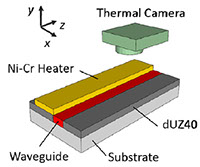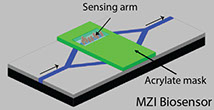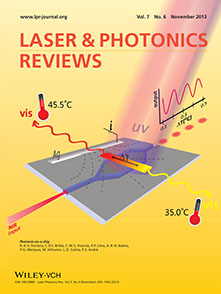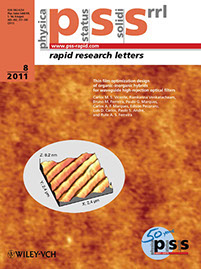


<
>
PHOTONIC HYBRIDS AND NANOMATERIALS GROUP
Aveiro-Portugal
university of aveiro
theoria poiesis praxis
physics department
ciceco
aveiro institute of materials



ORGANIC-INORGANIC HYBRIDS FOR PHOTONICS AND INTEGRATED OPTICS
Information and Communication Technology (ICT) is increasingly important in our daily life, although it is also a major energy consumer. Thus, the main ICT societal challenges are to become faster and more energy-efficient. To meet both demands, photonic integrated circuits have been playing an increasingly important role replacing electronic by optical transmission. In parallel with the technological aspects, these circuits should also meet the requirements for sustainability and carbon footprint associated with deployment, manufacturing and recycling issues, which are relevant to encounter Green Photonics. PHANTOM-G is developing low-cost optical devices based on organic-inorganic hybrids, demonstrating their potential to break cost-performance barriers.
Research breakthroughs:
- Thermal actuated Mach-Zehnder interferometers
- Coherent receivers
- Biosensors
- Electro-optic Mach-Zehnder modulators
- Thermo-optic variable wave plates
- Fabry-Perot cavities
- Optical filters
PEOPLE
Rute A.S. Ferreira
Paulo André
Luís D. Carlos
Carlos D.S. Brites
RESEARCH HIGHLIGHTS
A. R. N. Bastos, C. M. S. Vicente, R. Oliveira-Silva , N. J. O. Silva , M. Tacão, J. P. Costa , M. Lima , P. S. André, R. A. S. Ferreira, “Integrated Optical Mach-Zehnder Interferometer Based on Organic-Inorganic Hybrids for Photonics-on-a-chip Biosensing Applications”, Sensors 18, 840 (2018); http://dx.doi.org/10.3390/s18030840
The development of portable low-cost integrated optics-based biosensors for photonics-on-a-chip devices for real-time diagnosis are of great interest, offering significant advantages over current analytical methods. We report the fabrication and characterization of an optical sensor based on a Mach-Zehnder interferometer to monitor the growing concentration of bacteria in a liquid medium. The device pattern was imprinted on transparent self-patternable organic-inorganic di-ureasil hybrid films by direct UV-laser, reducing the complexity and cost production compared with lithographic techniques or three-dimensional (3D) patterning using femtosecond lasers. The sensor performance was evaluated using, as an illustrative example, E. coli cell growth in an aqueous medium. The measured sensitivity (2×10−4 RIU) and limit of detection (LOD = 2×10−4) are among the best values known for low-refractive index contrast sensors. Furthermore, the di-ureasil hybrid used to produce this biosensor has additional advantages, such as mechanical flexibility, thermal stability, and low insertion losses due to fiber-device refractive index mismatch (~1.49). Therefore, the proposed sensor constitutes a direct, compact, fast, and cost-effective solution for monitoring the concentration of lived-cells.
C. M. S. Vicente, P. P. Lima, V. de Zea Bermudez, L. D. Carlos, P. S. André, R. A. S. Ferreira, “Fabrication of Low-Cost Thermo-Optic Variable Wave Plate Based on Waveguides Patterned on Di-Ureasil Hybrids”, Opt. Express. 22, 27159–27168 (2014); http://dx.doi.org/10.1364/OE.22.027159
An integrated variable wave plate device based on a thermo-optic effect was fabricated by patterning a waveguide channel through direct UV laser writing on the surface of sol-gel derived organic-inorganic hybrid (di-ureasil) films. The di-ureasil layer is stable up to 250 °C and has a high TO coefficient calculated as −(4.9 ± 0.5) × 10−4 °C−1 at 1550 nm. The waveguide temperature was tuned, inducing optical phase retardation between the transverse electric and transverse magnetic modes, resulting in a controllable wave plate. A maximum phase retardation of 77 ° was achieved for a waveguide induced temperature increase of 5 °C above room temperature, with a power consumption of 0.4 W. The thermal linear retardation coefficient was calculated to be 19 ± 1 °/ °C.
R. A. S. Ferreira, C. D S. Brites, C. M. S. Vicente, P. P. Lima, A. R. N. Bastos, P. G. Marques, M. Hiltunen, L. D. Carlos, P S. André, “Photonic-on-a-chip: a thermal actuated Mach-Zehnder interferometer and a molecular thermometer based on a single di-ureiasil organic-inorganic hybrid”, Laser Photonics Rev. 7, 1027–1035 (2013); http://dx.doi.org/10.1002/lpor.201300080 [HIGHLITHED IN THE COVER]
An integrated photonic-on-a-chip device based on a single organic-inorganic di-ureasil hybrid was fabricated for optical waveguide and temperature sensing. The device is composed by a thermal actuated Mach-Zehnder (MZ) interferometer operating with a switching power of 0.011 W and a maximum temperature difference between branches of 0.89 °C. The MZ interferometer is covered by a Eu3+/Tb3+ co-doped di-ureasil luminescent molecular thermometer with a temperature uncertainty of 0.1°C and a spatial resolution of 13 μm. This is an uncommon example in which the same material (an organicinorganic hybrid) that is used to fabricate a particular device (a thermal-actuated MZ interferometer) is also used to measure one of the device intrinsic properties (the operating temperature). The photonic-on-a-chip example discussed here can be applied to sense temperature gradients with high resolution (10−3 °C·μm−1) in chip-scale heat engines or refrigerators, magnetic nanocontacts and energy-harvesting machines.
C. M. S. Vicente, R. Venkatachalam, B. M. Ferreira, P. G. Marques, C. A. F. Marques, E. Pecoraro, L. D. Carlos, P. S. André, R. A. S. Ferreira, “Thin film optimization design of organic–inorganic hybrids for waveguide high-rejection optical filters”, Phys. Status Solidi RRL 5, 280–282 (2011); http://dx.doi.org/10.1002/pssr.201105283 [HIGHLITHED IN THE COVER]
We report the fabrication of transparent, low surface roughness (<0.1 nm), and low-loss (1.5 ± 0.2 dB cm–1, 532 nm) thin films of organic–inorganic hybrids with controlled refractive index values stable under aging. High-rejection optical filters based on first-order Bragg gratings inscribed in channel waveguides were fabricated using UV-laser writing. Their high-rejection figure of merit (∼24 dB) is the best value found until now for organic–inorganic hybrids reinforcing the potential of sol–gel technology in the integration of optoelectronic components based on hybrid materials, namely in the fabrication of cost-effective integrated optics devices.




MADE BY PHANTOM-G, AVEIRO, PORTUGAL
